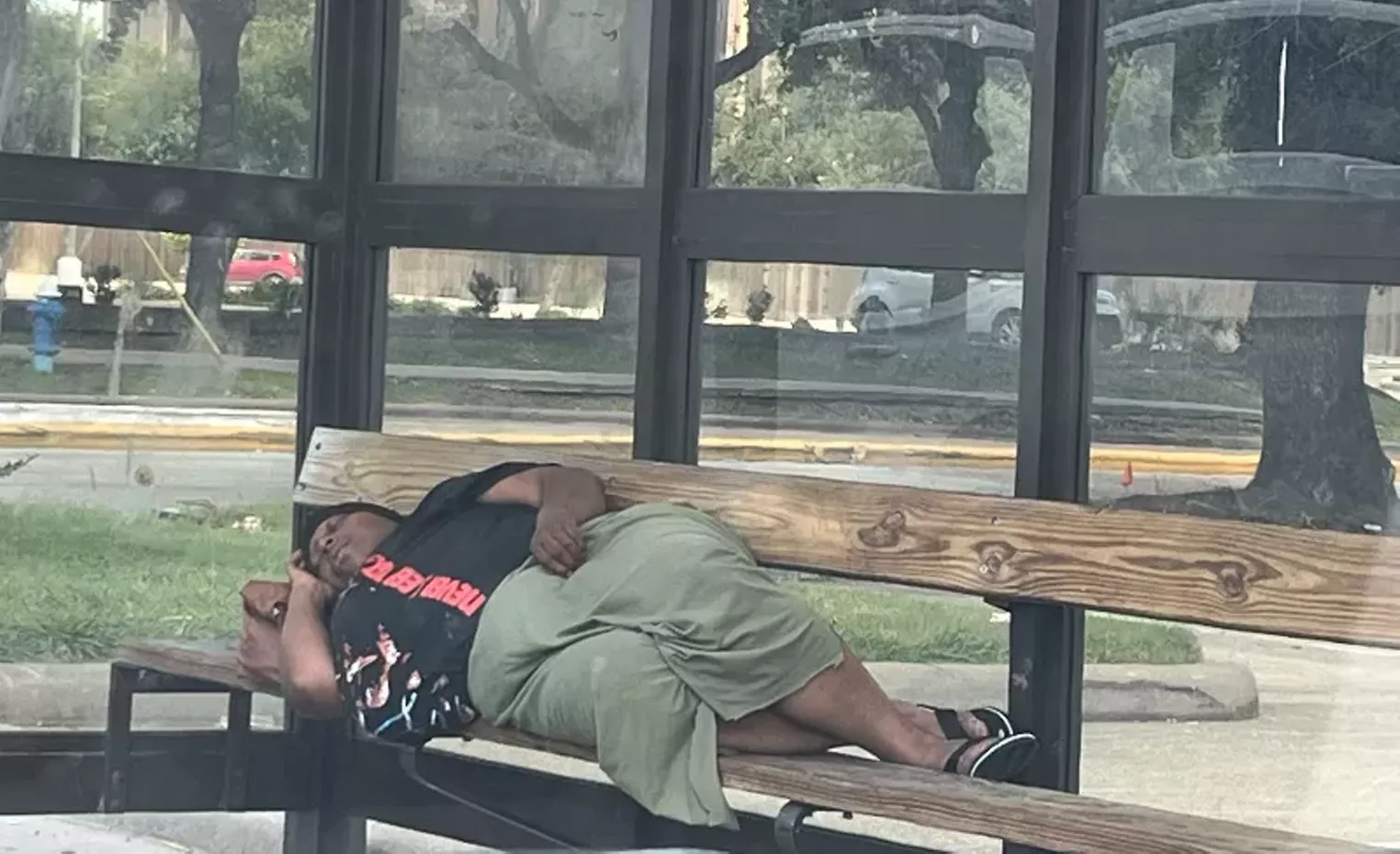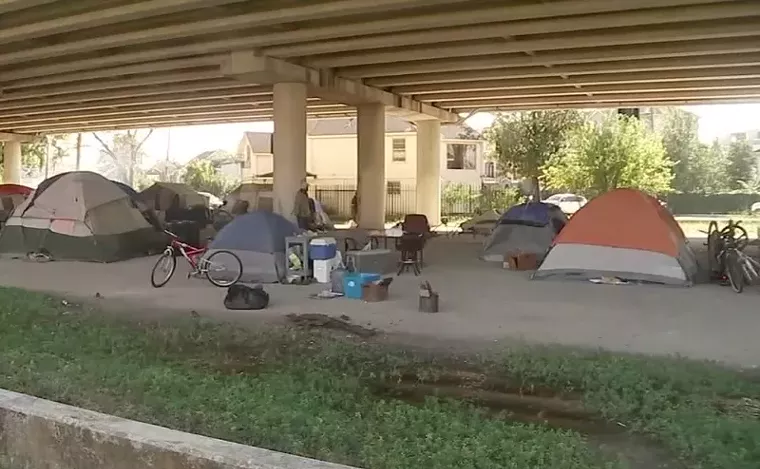There’s an elderly man who “stays” under an overpass at Telephone Road and frequently appears disoriented. There are maggots in the open wounds on his face, according to Houston City Council Member Twila Carter.
“He doesn’t even know where he’s at, let alone that he’s in a crisis,” Carter said.
Houston’s controversial “civility ordinance,” characterized by opponents as the criminalization of homelessness, was recently expanded to prohibit people from gathering and sleeping on sidewalks at all hours of the day and night in the Central Business District and East Downtown.
Such an ordinance is already on the books for many parts of the city, restricting people from sitting, lying down or placing personal possessions on sidewalks from 7 a.m. to 11 p.m.; the new law prohibits such actions in the designated areas 24/7.
Violators can face a fine of up to $500. Few are able to pay the fine or even show up to the city’s “homeless court,” but those who do appear in court are offered assistance. The goal, officials emphasized, is to move people to permanent supportive housing or a hospital, shelter or treatment center. Those in mental health crisis are taken by ambulance to a psychiatric hospital or emergency room.
Houston Police Department Public Information Officer Erika Ramirez said HPD officers do not question immigration status, “period, not just when approaching people who may be unhoused.”
The pilot program for just two designated areas was designed to help people with such severe mental illness that they are close to death and don’t even know it, said Houston Director of Public Safety and Homeland Security Larry Satterwhite at a July 16 council meeting. As more housing opportunities come online, the program will expand to other regions of Houston, he said.
“We lose hundreds of people every year on the streets,” Satterwhite said. “They die under bridges. They die on sidewalks. They die rolled up in blankets and clothing and in their own human waste after three or four weeks without ever having changed. Right now our sidewalks are our waiting room because we need more beds and we need more investment.”
“The simple fact is, what we allow, we encourage,” he said. “We have to do things differently if we want to solve the problem. It takes courage because we’re saying we need to do things differently. If we don’t start making some changes, we have some that their way off the street will be on a gurney.”
This isn’t an enforcement effort; it’s a humanitarian effort, Satterwhite explained.
“We’re trying to get in front of them, build that relationship, tell them we have help, we have offers of hope, and we can get them there, but also hold the line because we have to be accountable,” he said. “Otherwise, some will never take our help because they don’t trust and they’re much more comfortable in the life that they have as opposed to stepping out there and taking the chance on something better.”
Houston Director of Public Safety and Homeland Security Larry Satterwhite, who previously served as acting HPD chief, is leading the effort to house the homeless and connect them with resources.
Screenshot
The program is funded with about $40 million in federal disaster recovery funds, and the city is seeking donations from private philanthropy groups. Houston currently has about 3,300 homeless people, according to a 2024 count by the Coalition for the Homeless of Houston/Harris County. The nonprofit counted 8,400 homeless people in 2011.
“We have reduced homelessness in Houston by over 60 percent,” said Council Member Abbie Kamin. “What we are doing is working and we still have a ways to go. To say we’re not doing something or the model we have isn’t working is a false narrative. Do we need more? Absolutely.”
Mayor John Whitmire campaigned on a promise to eliminate homelessness in Houston, and the pressure to do so is mounting as the city plans to host about 500,000 tourists for the FIFA World Cup next year. Aside from having the appearance of a clean and orderly city for guests, Houston has the best interests of the unhoused at heart, the mayor said earlier this month.
“I don’t know why the people who question it would support the status quo when you leave here daily and see the sick, particularly the mentally ill, living under bridges and in our parks,” Whitmire said. “There’s a plan. No one is going to be taken off the streets unless there’s a bed and a plan to get them mental health services.”
In response to concerns about patrol officers’ training to deal with persons in mental health crisis, Whitmire said the city is partnering with The Harris Center for Mental Health and IDD.
The City Council voted 14-2 to expand the civility ordinance on July 16. Council members Tarsha Jackson and Kamin voted against it. Kamin said she was concerned that the ordinance would outlive those who crafted and adopted it, and future city leaders may not have the same intent as the current panel.
The council will revisit the ordinance in six months, at which time recommendations can be made on further amendments and enforcement.
“If we think there’s been police overreaching, we can address that,” said Councilman Julian Martinez. “I don’t think anyone wants to criminalize homelessness.”
Council members unanimously agreed that the ordinance would encourage, but not require, the presence of mental health professionals and officers with special training in crisis response prior to enforcement.
Satterwhite’s team is moving at the speed of the available resources, the director said. Outreach officers have on hand the number of jail diversion beds and restricted and unrestricted hospital beds when they approach homeless people on the streets The city’s housing department, in partnership with local nonprofits, is focused on providing transitional beds, services and a path to permanent housing.
“This is clearly not about incarcerating people,” said Housing and Community Development Director Mike Nichols. “Sadly we have too many people who are already incarcerated who are homeless, and that’s a huge cost. It’s about a very definitive way to help people with their issues.”
“Your public wants this,” Nichols told the City Council. “They want it citywide.”
Houston has provided housing to about 85 people since it began clearing encampments in November.
Screenshot
There are still, however, some concerns from Houston residents and professionals who want to help the homeless.
Dr. Mudit Gilotra, associate medical director at Healthcare for the Homeless Houston, said he supports Whitmire’s plan to end homelessness but is concerned that well-intentioned changes to the civility ordinance could inadvertently create barriers and resistance from the people who need help.
Gilotra referred to a homeless woman named Cathy to whom he’s provided medical care for years. She was offered an apartment by the Coalition for the Homeless but was reluctant to accept it, telling the doctor she believed those who said they wanted to help intended to cause her harm.
“Cathy, since she was evicted by our own housing system, developed a deep distrust of the system and therefore repeatedly turned down any further help,” he said.
Last week, the doctor said he convinced Cathy to look at the apartment.
“This is a monumental step forward for her,” Gilotra said. “That decision was a result of years of trust-building. I know the intent is not to collect money from people; it’s not to actually arrest people. However, if Cathy had perceived even the threat of citation or arrest, I’m confident she would have fled and we would not be able to find her. She would have died on the street.”
Saba Blanding, a member of Trinity Episcopal Church in Midtown, said her faith compels her to care for the poor.
“Making it unlawful for persons to be sitting or lying on public sidewalks is not a tool to get people the help they need. It is a tool to criminalize the unhoused,” she said. “It does not provide services or safety. It is legalizing the internment of the unhoused in county jail.”
According to Satterwhite, the pilot program is actually designed to provide services and protect the safety of the homeless. He invited churches and groups that feed and care for the homeless to work in partnership with law enforcement.
“We have fantastic people out there trying to help those they see as hurting and vulnerable,” Satterwhite said. “We’re not saying stop. We’re saying work with us because right now, your effort, which is to be applauded, is maybe working against what we’re trying to do overall. It actually anchors people to an area when we’re trying to get them off the streets and to a better place.”
Significant discussion at the July council meeting centered on how to help those who don’t want to be helped. Some refuse housing because of a lack of trust or because they are dependent on the drugs they get on the streets, Satterwhite said.
“They may turn us down and we’ll advise them of the law,” Satterwhite said. “For our program, we’re intentionally going into areas and we have beds identified and we’re going to follow up with a nonprofit and make those offers.”
Carter emphasized the homeless people who continue to suffer outdoors because they’re unable to make housing decisions for themselves.
“This tool, friends, is really about being able to address this population,” she said. “In an encampment, you’ve got, ‘Hey, I get a social security check, I’m good out here,’ and the person next to them says, ‘I don’t have an ID, I need help.’ When you come across the ones that are so mentally ill that they don’t even know that their face is rotting off, that’s a problem.”


